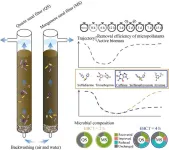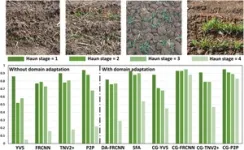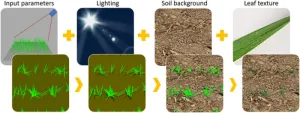Sand filters are commonly applied in drinking water treatment and can efficiently remove suspended solids, organic matter, and microorganisms from source water. During the process, particulate matter and microbes can attach to filter sands and develop a thick biofilm in both rapid and slow sand filters. To prevent clogging and restore pollutant removal efficiency, backwashing using air, water, or a combination of both is usually required for sand filters. However, backwashing can induce a loss in biomass, thus decreasing the pollutant removal efficiency of sand filters. Slow sand filters whose empty bed contact times (EBCTs) are typically longer than 1 h, have a higher removal efficiency of micropollutants than rapid sand filters, whereas clogging issues are more severe.
Slow sand filters can remove a fraction of the dissolved organic carbon, ammonium, and manganese through microbial transformation and degradation. Additionally, recent evidence suggests that some organic micropollutants can be removed by sand filters, which is at least partly attributed to the biofilm formed in the filter sands. Owing to the limited micropollutant adsorption onto sand material, biodegradation of micropollutants by indigenous microbial populations is the most crucial removal mechanism of micropollutants in slow sand filters. During backwashing, the water and air used can expand the volume of the filter media, and thus strip and remove the biofilm from the filter sands. Therefore, biofilm formation occurs periodically in the slow sand filter, and microbial community dynamics are crucial for pollutant removal in the sand filter after backwashing. However, few studies have focused on microbial biofilm community dynamics after backwashing.
To solve this problem, Dr. Yaohui Bai from the Chinese Academy of Sciences and his team members worked together to reveal the temporal dynamics of both the concentration of micropollutants and the microbial community after backwashing and to indicate the optimal intervals for backwashing slow sand filters for micropollutant removal. They conducted a laboratory column experiment to track the dynamics and resilience of the microbial biofilm community and the corresponding micropollutant removal after backwashing with slow sand filters. Two types of filter materials, manganese and quartz sand filters, were used to fully compare the influence of backwashing on the microbial community in slow sand filters under two different empty bed contact times (EBCTs). This study entitled “Impacts of backwashing on micropollutant removal and associated microbial assembly processes in sand filters” is published online in Frontiers of Environmental Science & Engineering in 2023.
In this study, the temporal dynamics of micropollutant removal and microbial community composition after backwashing were tracked, and the removal efficiencies of caffeine, sulfamethoxazole, sulfadiazine, trimethoprim, and atrazine gradually recovered within 2 d in both sand filters at 2-h EBCT, whereas declining trends in sulfadiazine and trimethoprim degradation were found at 4-h EBCT. After backwashing, the removal efficiency of atenolol in the manganese sand filter increased rapidly but remained at a high level (almost 100%) in the quartz sand filter for both EBCTs. Correspondingly, the active biomass recovered within 2 d under all conditions. Microbial community composition gradually recovered to the pre-backwashing level at 2-h EBCT, and the recovered microbes accounted for 82.76 % ± 0.43 % and 46.82 % ± 4.34 % in the manganese and quartz sand filters, respectively, at 2-h EBCT. In contrast, at 4-h EBCT, the community composition in sand filters did not recover to the pre-backwashing level (R < 0.25), and the depleted microbes were the major group in both types of sand filters.
This study explored variations in micropollutant degradation and temporal dynamics of the microbial community after backwashing for the first time. It is indicated that a 2-d optimal interval for the recovery of micropollutant removal after backwashing should not affect the operation of slow sand filters with a short EBCT. It has deepened our understanding of the effect of microbial biofilm community on the removal of pollutants in sand filter, and provides a new perspective for the removal of pollutants in drinking water.
###
About Higher Education Press
Founded in May 1954, Higher Education Press Limited Company (HEP), affiliated with the Ministry of Education, is one of the earliest institutions committed to educational publishing after the establishment of P. R. China in 1949. After striving for six decades, HEP has developed into a major comprehensive publisher, with products in various forms and at different levels. Both for import and export, HEP has been striving to fill in the gap of domestic and foreign markets and meet the demand of global customers by collaborating with more than 200 partners throughout the world and selling products and services in 32 languages globally. Now, HEP ranks among China's top publishers in terms of copyright export volume and the world's top 50 largest publishing enterprises in terms of comprehensive strength.
The Frontiers Journals series published by HEP includes 28 English academic journals, covering the largest academic fields in China at present. Among the series, 12 have been indexed by SCI, 6 by EI, 2 by MEDLINE, 1 by A&HCI. HEP's academic monographs have won about 300 different kinds of publishing funds and awards both at home and abroad.
About Frontiers of Environmental Science & Engineering
Frontiers of Environmental Science & Engineering (FESE) is the leading edge forum for peer-reviewed original submissions in English on all main branches of environmental disciplines. FESE welcomes original research papers, review articles, short communications, and views & comments. All the papers will be published within 6 months since they are submitted. The Editors-in-Chief are Prof. Jiuhui Qu from Tsinghua University, and Prof. John C. Crittenden from Georgia Institute of Technology, USA. The journal has been indexed by almost all the authoritative databases such as SCI, Ei, INSPEC, SCOPUS, CSCD, etc.
END






